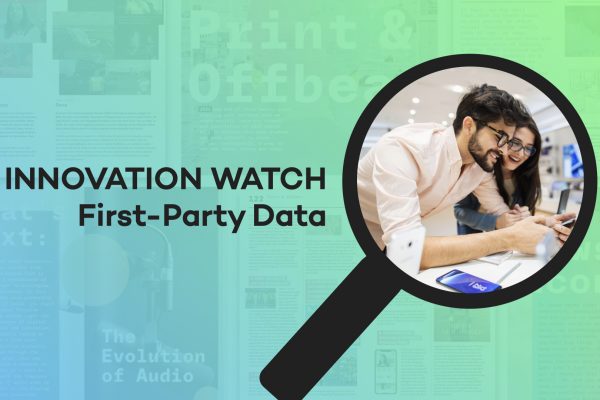Innovation Watch: How to create your own first-party data play
Welcome to FIPP’s latest editorial series, which will this summer examine the eight most important areas of innovation taking place in global media right now. From cookies to conversions, print to product teams, and beginning here with the all-important first-party data play, we’ll take a look at everything you need to build a cutting-edge media company for the post-pandemic era!
The series is based on FIPP’s 2022-23 Innovation in Media World Report, which – published in partnership with the Innovation Media Consulting Group – provides the most comprehensive guide to media strategy available on the market today. If you want the full publication, then you’ll need to purchase a copy (or be a FIPP member), but in the meantime, we hope here to provide some open intelligence on some of THE key trends shaping our industry…
What is first-party data?
A simple question that by now we’re all familiar with the key soundbite for: First-party data is the information that you collect directly from your own audiences. But I also like to think it has been thusly named because it represents a throwback to the ‘first party’ – a period of digital evolution before the media tech giant monopoly had fully taken hold, and the quality content machines had become clogged with cookie dough.
Of course, to what extent Cookiepocalypse will positively affect publishers of various different shapes and sizes, versus causing others headaches, remains uncharted. What we do know is that these changes are coming, and as the primary purveyors of quality contextual environments, media owners are ideally placed to benefit from them, both from a reader revenue and a more traditional advertising pov.
How can I be first to the party?
Brace yourself for the cookiepocalypse, begins the 2022-23 Innovation in Media World Report, ‘and then breathe… and start to look beyond, for there is life after the cookie (and other types of third-party data).
Over 2020, as companies first grappled with the news of Chrome’s impending third-party cookie phaseout, Boston Consulting Group and Google interviewed marketing executives at 23 companies and seven advertising agencies across the US. Their key findings show that top brands are set to take the following three actions:
Develop a comprehensive data strategy
The BCG report points out that many brands simply collect as much of that data as possible in the belief that collection itself would somehow translate to value. But attempting to collect unneeded data burdens customers, increases the cost of technology and personnel and raises the risk of data breaches and other privacy violations. The best brands create organisation-wide strategic goals for collection and investment in such data and also identify what data is essential.
Many brands simply collect as much… data as possible in the belief that collection itself would somehow translate to value. But attempting to collect unneeded data burdens customers
Test, learn, and measure to determine the best activation methods
First party data can be great for delivering personalised experiences. BCG recommends that companies should use a test-and-learn approach to determine what should be personalised and what level of personalisation is needed.
“This could mean, for example, focusing on only one customer segment and investing only in the data and technology required to test that particular use case,” the report notes. Once value is proven, brands can deploy additional technology such as artificial intelligence and machine learning and expand personalisation efforts to new customer segments and journeys.
Build robust in-house tech capabilities while relying on strategic partners for other kinds of expertise
Brands need to think more strategically about working with agencies rather than outsourcing all aspects of marketing to them, BCG notes, adding that it is more efficient and effective to consider which capabilities are best kept in-house and which ones an agency can provide. They recommend a hybrid approach where the technology stack and capabilities related to data analysis are kept in house while agencies can provide strategic advice.
A number of leading publishers have already made significant strides in building up their own first party-data platforms over the last 12 months and beyond. Apart from the collection of scalable and authentic data, these efforts include creating easily accessible audience segments for advertisers to use that data.

Further reading
The chapter goes onto examine specific examples in further detail, from leading media owners including The New York Times, Future, The Washington Post, and more, and as discussed you can find out more about accessing the publication in full here.
In addition to launching Innovation at FIPP World Congress earlier this month, we also launched a comprehensive report dedicated entirely to this very subject. Written by Martha Williams, CEO of the World Newsmedia Network and dubbed the ‘First-party data playbook for publishers’, the 60 page study acts as a quintessential handbook for implementing such strategies across different business models throughout the media world… and you can find out more about that one here.
We’ve also just published our latest Global Digital Subscriptions Snapshot here. This one is less about strategy and more about surveying the landscape. But if you want to get a birdseye view on how the subscriptions side of the industry is currently evolving – a key component in the first-party data play, then this provides the most comprehensive quarterly report on the global digital subscriptions market today.
For those looking to get underneath the bonnet and into the nuts and bolts, subscription management platform Zephr have just published a new guide. ‘Behind the Scenes: Achieving Significant Results with Data’ is FREE to download, and you can do so here.

On a related note, there’s a GREAT short story on a recent Bauer subscriptions update here, which has seen the company launch Inside Empire – a series of virtual events exclusive to members of the Empire magazine VIP Club, currently priced at £7.99 PCM.
And of course, for everything else, please stay tuned to the FIPP.com! This is a subject that we’re regularly covering, from numerous different perspectives, including in this Congress round-up piece published by FIPP Reporter, Sadie Hale, just last week.









